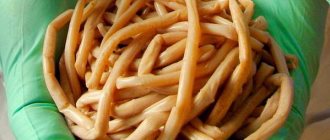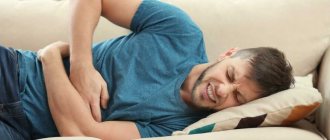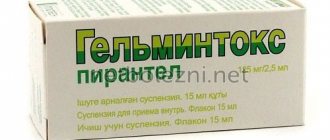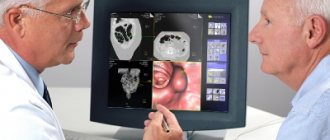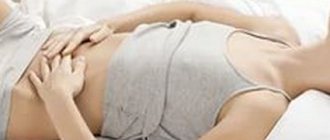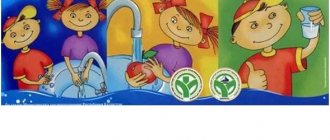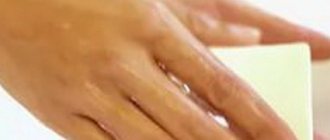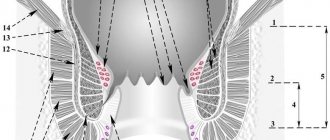The article was prepared by a specialist for informational purposes only. We urge you not to self-medicate. When the first symptoms appear, consult a doctor.
Unfortunately, helminths are frequent guests in children’s bodies, because children interact with wildlife very actively: they touch animals, pick up dirty objects from the ground, eat unwashed fruits, vegetables and berries, drink unboiled water, etc. To protect your child from helminthiasis, you need to learn how to quickly identify the symptoms of parasitic infestation so that diagnosis and treatment can be carried out on time. You should not hesitate in treating worms in children, because parasites are not at all as harmless as they might seem at first glance.
Symptoms of helminth infections in children vary depending on the stage of the disease (acute or chronic) and the type of helminths, of which there are a great many in nature: the human body can become a “haven” for more than 100 types of worms. However, the most common among them are pinworms and roundworms.
In Russia, more than 2 million cases of visiting a doctor with helminthic infestation are registered during the year. Judging by the number of anthelmintic drugs sold, the actual number of people infected is 10 times higher, and about 80% of patients are children. Helminthology knows more than 300 species of parasites, 70 of them affect residents of Russia. Worms in children – erased symptoms, absence of specific manifestations.
Infection with helminths can occur by airborne droplets, through the skin or by the fecal-oral route.
Types of worms that affect children
Helminths that live and reproduce in the human body are divided into 3 groups:
- Nematodes, or roundworms - pinworms (the causative agent of enterobiasis), roundworms (the causative agent of ascariasis), trichinella (the causative agent of trichinosis), whipworm (the causative agent of trichocephalosis), etc. This group of helminths is most often found in young children.
- Cestodes, or flat (tape) worms - echinococcus, bovine tapeworm (causative agent of taeniarinosis), rat tapeworm (causative agent of hymenolepiasis), pork tapeworm (causative agent of taeniasis).
- Trematodes, or flukes – Siberian or cat fluke (the causative agent of opisthorchiasis), liver fluke (the causative agent of fascileosis), etc.
The localization of parasites is the digestive tract, liver, brain, lungs, heart, retina, bile ducts and gallbladder, pancreas. Helminth larvae and adults move throughout the body with the bloodstream.
Whipworm and Echinococcus
There are practically no worms in infants
These parasites are not as common in children as pinworms and roundworms. Whipworms get their name due to their resemblance to hair. They are very thin, up to 5 cm long. At one end they have a thinning, with which they are attached to the intestinal walls. This worm has some features:
- The whipworm feeds not on food debris, but on blood and intestinal mucosa.
- The whipworm reproduces very actively. The female can lay up to 2 thousand eggs at a time. Moreover, eggs passed with feces can develop independently in an open environment.
- The parasite violates the integrity of the intestinal lining, leaving tiny damage and hemorrhages with its hairs. This leads to various intestinal dysfunctions. In weakened children, rectal prolapse may occur. It can also lead to various peptic ulcers.
The main feature of whipworm infection is the absence of typical symptoms. They may appear partially or resemble other gastrointestinal diseases. Whipworm cannot be identified without laboratory testing.
Treatment is carried out at home. Only children with serious complications should be hospitalized. Typically, your doctor will prescribe deworming medications, as well as probiotics and digestive enzymes.
Echinococcus is a tapeworm that is most often found in stray animals. This worm itself is small, up to 5 mm in length, but they are quite dangerous for humans. People and some domestic animals (pigs, sheep) are intermediate hosts.
The egg, entering the body, forms a capsule, which begins to grow and turns into a cyst. The egg can enter the body of the final host (dog or wolf) only through eating an infected organ, so a person is most often a dead end for the development of echinococcus.
The cyst grows slowly, so symptoms may not appear for a long time. When the cyst reaches a sufficient size, the infected organ begins to hurt. The liver, lungs, or other organs may be affected. If the cyst ruptures, anaphylactic shock and death occur.
This dangerous parasite can only be removed surgically, by cutting out part of the organ with the cyst. If there are many cysts and several organs are affected at once, the chances of death increase significantly.
How do children become infected and why?
The vast majority of cases of helminthic infestation are due to nematodes (ascariasis, enterobiasis, trichocephalosis). Infection with cestodes and trematodes accounts for 2 to 5% of all cases of helminthiasis. The cause of infection with tapeworms and flukes is travel to the tropics and subtropics, consumption of poorly fried or boiled meat, game, fish (infection with the broad tapeworm), as well as contact with animals that carry the infection.
Roundworms and pinworms enter a child's body when eating food with dirty hands, eating poorly washed berries, fruits and vegetables, and through contact with animals or carriers of ascariasis and enterobiasis.
When children are infected with pinworms, self-infection often occurs when the hands that the child used to scratch the skin around the anus transfer thousands of eggs onto toys, linen, household items, dishes, and door handles. He becomes infected again and infects his family members.
Children of primary preschool age taste everything that comes into their field of vision. Therefore, places where children have frequent contact with each other (playgrounds and kindergartens, playrooms in educational and shopping centers) become breeding grounds for helminth eggs. The defense system of a small child’s body is not yet perfect, and the need to observe hygiene rules has not yet developed.
The situation is aggravated by an imperfect system for detecting helminth infections. Erased symptoms, or their complete absence, may accompany the development of worms in children. This is why parents find it difficult to determine the causes of illness when complications of helminthiasis develop.
For example, the development cycle of pinworms makes it possible to detect symptoms of its presence only during a certain period of the development cycle. A scraping taken from a child at the wrong time may be false negative. That is why it is recommended to scrape the worm eggs three times: with a break of 2-3 days between them, and again, after 2 weeks.
Reasons for the increased risk of infection of children with ascariasis and enterobiasis:
- Irregular hand washing before eating, after a walk, or after contact with animals;
- Rare change of underwear, less than 2 times a day, or once in the morning.
- Persistent habit of putting toys in the mouth, sucking a finger, biting nails;
- Lack of nail care for children;
- Unsanitary conditions in the child’s home, the presence of flies and cockroaches;
- Contact with domestic animals that carry helminths on their fur and paws after a walk;
- Careless washing of vegetables, berries, herbs and fruits before eating.
Methods to combat these diseases
Diagnostics
Radiography is a method for diagnosing helminth infection.
In order to be able to effectively fight helminthiases, the first step is to establish the cause of the disease, to determine exactly what type of helminths we are talking about and whether they are the problem. Therefore, first you need to conduct a correct diagnosis. The wide variety of manifestations of worm infection leads to the fact that almost any pediatrician can deal with helminthic diseases in children: pediatrician, surgeon, immunologist, dermatologist, gastroenterologist and others. For this reason, children with various allergic diseases, gastrointestinal and pulmonary disorders, and chronic dermatoses should in any case be examined for helminth infection.
In the severe phase of helminthiasis in children, changes in the blood are especially noticeable, so various blood tests can help identify helminthiasis. Also, biological material for determining the presence of worms in children are feces, bile and sputum. The most common method for diagnosing helminthic diseases in children is stool analysis for helminth eggs. Scraping for enterobiasis is performed to detect pinworm eggs. Instrumental techniques - radiography, ultrasound, etc., are important in diagnosing echinococcosis. With their help, you can identify cysts in various organs and their tissues. For trichinosis, a biopsy of the skin and muscles is performed - using this technique, Trichinella larvae are detected, a type of roundworm. Opisthorchiasis is accompanied by the study of the contents of the duodenum using the method of duodenal intubation. Various allergy tests are also used to diagnose helminthiases.
Therapy
Targeted treatment of helminthiases in children is carried out using special anthelmintic drugs. The main principle of therapy is the correct selection of a drug that should have larvicidal, ovicidal and vermicidal effects. Each of these actions destroys helminths at different stages of their development: larvae, eggs, adults, respectively. After completing the treatment course, a follow-up examination is required. This is necessary to ensure the success of the therapy.
The prescription of an anthelmintic drug occurs after a preliminary determination of the form of helminthiasis, the phase of development of the disease, and various concomitant diseases. Thus, the same drugs can be effective in the case of a number of helminthic diseases in children: for ascariasis, enterobiasis, trichinosis, trichocephalosis, the use of albendazole and mebendazole is effective; pyrantel is effective in cases of ascariasis and enterobiasis; praziquantel is a drug used for opisthorchiasis, taeniasis, diphyllobothriasis, etc. Effective treatment of helminthiases involves simultaneous treatment of the whole family and strict adherence to a sanitary regime to prevent cases of re-infection. After 10-15 days, a repeated drug course of treatment is carried out.
General signs of worms in a child
Helminths are very dangerous for a child’s body, because the products of their vital activity and decay can cause serious intoxication and allergies, even toxic shock. In addition, helminths deprive the child of what is vital for full growth and development: vitamins and minerals. Their deficiency in the body also reduces the child's immunity, making him vulnerable to other diseases.
Worm infestation in children most often occurs in the warm season - late spring, summer and autumn, when children spend a lot of time outside, eat fresh, unwashed fruits, vegetables and berries with dirty hands and play with yard animals.
Symptoms of worms in children can be so unnoticeable or mild that a person does not feel that he is a carrier of the infestation. The activity of parasites is activated under unfavorable circumstances, with a decrease in the standard of living, and a decline in immunity. It is quite possible that worms are the cause of the appearance of some pathologies of internal organs and oncological processes.
The first symptoms of helminthic infestation in children are weakness and irritability. The child is capricious, sleeps poorly, complains of abdominal discomfort and headaches. There are changes in appetite: it either decreases or increases. Attacks of nausea and vomiting are also typical, and stool disturbances are observed (constipation alternating with diarrhea). Also, sometimes children may experience an increase in body temperature for no reason (up to 37.3 °C). In some cases, allergies to helminth waste products cause skin itching and rashes. Infected children have pale skin and dark circles around the eyes.
A clinical blood test for helminthic lesions of the body usually shows a high level of eosinophils, which indicates an allergic reaction. A decrease in hemoglobin is characteristic.
Description of the disease
Helminthic infestation or helminthiasis (damage to the body by worms) is a widespread phenomenon in childhood. Few children have not suffered from helminthiasis at least once in their life. Manifestations of the disease, as a rule, are known to everyone: the child suffers from itching in the anus (intensified at night), stomach upset, loss of appetite, and a feeling of fatigue.
While in the intestines, the worms feed at the expense of the host’s body, affecting internal organs and systems. Currently, more than 300 varieties of worms are known. The most common in childhood are pinworms and roundworms.
Helminthic infestation requires immediate treatment by a qualified gastroenterologist. While in the child’s body, worms disrupt the process of absorption of nutrients, their waste products have a negative effect on the gastrointestinal tract, and, if left untreated, can affect other vital organs - the lungs, brain, etc.
Signs of pinworms in children
Pinworms are helminths that cause enterobiasis; they are small worms up to 1 cm long. An infected child scatters pinworm eggs in his environment, on clothes, door handles, toys, and dishes. For pinworms, UV radiation, boiling, and some disinfectants are dangerous. Pinworm eggs enter the mouth, and from there into the intestines. After a few days, larvae emerge from the eggs, they become sexually mature and are ready to reproduce and lay eggs. One life cycle of a pinworm is only 2 weeks.
A pronounced symptom of these worms in children is nighttime itching in the folds of the anus, when the body warms up in a warm bed and its muscles relax. The pinworm crawls onto the skin near the anus and lays more than 5,000 eggs in its folds. By scratching the irritated skin of the anal area, the child spreads these eggs under the nails. In addition to itching, you can find skin damage from scratching in a child.
Additional symptoms of enterobiasis in children:
- Restless sleep due to disturbing itching, possible insomnia, crying at night;
- Weight loss, insufficient weight gain due to age;
- Excitability, increased fatigue, moodiness, attention deficit, memory impairment;
- Enuresis in girls due to pinworms entering the urethra;
- Vulvovaginitis due to irritation of the vagina by helminths crawling there, less often - inflammation of the appendages and uterus;
- Development of acute appendicitis due to the accumulation of pinworms in the cecum;
- Night grinding of teeth is a presumptive symptom;
- Digestive disorders – dysbacteriosis, enterocolitis, diarrhea;
- Anemia, increased morbidity due to a deficiency of nutrients, vitamins, microelements;
- Intoxication phenomena as a consequence of toxic poisoning of the body (weakness, weight loss, nausea, headache).
Rules of therapeutic therapy
All anti-worm medications for children are highly toxic. Only a specialist should decide what will help better. In addition to collecting information about the main symptoms, referrals for tests will be given.
You will need to take a stool test several times with an interval of 1-2 days, a blood test for the presence of antibodies to helminths, scraping with adhesive tape or a cotton swab from the area of the anal folds, a general blood and urine test.
The results will help determine the type of helminths, the degree of their prevalence and the stage of the disease and decide how to treat worms in a child.
The dosage of the active substance is calculated based on the patient’s weight, age and severity of the disease.
For children over 6 years of age, anti-worm medications can be prescribed with a wide or narrow spectrum of action. Often several types of helminths can be found in a child’s body, so drugs with a wide spectrum of activity come to the rescue.
Sometimes it is difficult to remove worms from a child. Therefore, the doctor may decide to prescribe several anthelmintic drugs, taken several days or weeks apart.
Anthelmintics should be chosen in the form of a suspension or powder for the preparation of a suspension. Many anthelmintic tablets cannot be crushed or chewed before swallowing, making them difficult to administer.
Signs of ascariasis in a child
According to statistics from laboratory studies, the incidence of worms in children is 80% of the total. Worms in children pose a serious problem for medicine, since worms deprive the child of nutrients and lead to organ pathologies and complications.
Ascariasis is one of the most dangerous types of worms in children. With a massive invasion, roundworms can penetrate any organ of the human body: intestines, liver, brain, lungs, pancreas, gall bladder, heart. Ascaris eggs enter the human mouth from the soil with dirty hands or food, where they are transferred from the soil, sand, legs of flies and cockroaches.
From the oral cavity, eggs with food enter the intestines, where they develop into larvae within 3 months. The grown larvae migrate through the blood vessels to other organs. Symptoms such as hyperthermia up to +38°C, weakness, dry cough with blood in the sputum, and increased fatigue appear. An X-ray examination reveals moving infiltrates in the lungs. Often a child with lung damage develops pneumonia, bronchitis, or bronchial asthma.
The primary phase of ascariasis is characterized by enlargement of the lymph nodes, liver, and spleen. Reaction to waste products of roundworms - allergic reactions in the form of urticaria of the hands and feet, dermatoses.
The secondary, late intestinal phase of ascariasis, which occurs 3 months after infection, roundworms return to the intestines. They get there along with sputum from the lungs swallowed by the child. Symptoms of this period are digestive disorders (abdominal pain, constipation, diarrhea, sudden weight loss, irritation of the anus, flatulence. Reduced immunity cannot protect the body from infections, pustular lesions of the skin and mucous membranes occur, stomatitis with frequent relapses.
The child’s nervous system suffers from the toxic effect of roundworms on the body. Children experience mental disorders - sleep disturbances, nightmares, epileptic seizures. Ascariasis causes serious consequences: inflammation of the peritoneum, appendicitis, intestinal obstruction due to the accumulation of a ball of roundworms in its lumen, obstructive jaundice due to the entry of larvae into the bile ducts.
Symptoms of helminth infection
Symptoms of helminthic diseases manifest themselves in different ways. They directly depend on which part of the body the parasite lives in, how intense the infection is, and what type of parasite the child is infected with. Signs of invasion appear at different rates. For example, after infection with roundworms, the patient may experience negative changes in health within a few days. In most cases, signs of worm infection appear after 14-20 days, and in the case of filariasis - half a year and a half after infection: this type of helminth has a very long incubation period. Intestinal helminths pose a particular danger of infection: when infected with just one individual, the disease is often asymptomatic. Signs of the disease can appear only when the parasite reaches enormous sizes, or when there is a massive infection. Common signs of helminthiasis include:
- increased fatigue
- dizziness
- dysfunction of the central nervous system
- headache
- irritability
Irritability is a symptom of helminth infection.
Since many symptoms of helminth infections depend on the type of worms that provoke them, we can consider what signs of the disease occur with a specific type of helminth. Pinworms (enterobiasis) - a characteristic symptom of infection with this type of nematode is itching in the anus, which is especially pronounced at night. The frequency of this sensation is explained by a non-massive infection with pinworms - it can manifest itself within one or two days, and then the patient does not experience it at all for a couple of weeks. This is a characteristic sign of pinworm infestation; with severe infection, itching occurs much more often.
Signs of other helminthic infestations
Worms in children trichocephalosis (caused by whipworm) - symptoms are minimal. Dyspepsia, bloody diarrhea, constipation, flatulence, anemia are possible; with prolonged intoxication, developmental delays in children of primary preschool age are diagnosed.
Another worm in children is hymenolepiasis (the causative agent is rat tapeworm) and has no specific symptoms. A disorder of the digestive tract may appear - abdominal pain, nausea and vomiting, constipation followed by diarrhea, heartburn. The child has decreased appetite, headache, increased salivation, allergic manifestations, rhinitis of unknown etiology.
Worms in children - opisthorchiasis (pathogen - Siberian fluke, cat fluke) - enlarged lymph nodes, allergic rashes, changes in blood count (ESR and the number of eosinophils are increased, hemoglobin is decreased). Additionally – low-grade fever, catarrh of the upper respiratory tract, digestive disorders. Symptoms of gastritis, hepatitis, pancreatitis, and myocardial dystrophy appear.
Diphyllobothriasis (the causative agent is the broad tapeworm, transmitted through fish that has not undergone full culinary processing) - anemia, allergies, digestive disorders, pain in the epigastric region.
Toxocariasis (caused by Toxocara) – carriers of the disease are domestic animals that transmit helminth eggs to humans. Preschoolers who come into contact with cats and dogs most often develop toxocariasis. Symptoms – allergic cough, itching, facial swelling, fever, hepatosis, enlarged lymph nodes. Eye damage is common - keratitis, chorioretinitis, ophthalmitis, which can become irreversible.
Symptoms of acute and chronic form
The symptoms of the disease depend not only on the type of helminthiasis, but also on the stage at which the disease is located. The acute phase is characterized by the following manifestations:
- Skin rash (called hives);
- Chills (febrile state);
- Enlarged lymph nodes (lymphadenitis, a sign of a malfunction of the immune system);
- Myalgia and so on;
- Dry cough, asthmatic type, shortness of breath and chest pain;
- Eosophilic pleurisy and hemoptysis are observed with ascariasis;
- Edema, of various types, up to Quincke's edema (a very life-threatening syndrome for a child);
- Flatulence, constipation or diarrhea are also common;
- Nausea, belching;
- There are acute pains in the abdomen;
- General weakness;
- Sleep disorder;
- Increased irritability;
- Cramps.
Symptoms of chronic helminthiasis in children:
- Lethargy;
- A sharp decline in academic performance and performance;
- Lack of appetite;
- Weight loss;
- Decreased hemoglobin;
- Chronic skin diseases, including atopic dermatitis, psoriasis, eczema and so on;
- Diseases of the respiratory system: bronchitis of the asthmatic type, rhinitis, tracheitis;
- Problems in the genitourinary system, including vulvitis;
- Decreased immunity leading to frequent colds.
Helminthiasis in children is a significant problem and leads to serious health problems. Up to the development of intestinal obstruction, jaundice, pancreatitis. Helminths in the lung tissue lead to pulmonary failure. Parasites in the eyeballs provoke strabismus and loss of vision.
Treatment of worms in children
Treatment of worms in children depends on the type of parasite and the degree of the disease. Drug therapy is usually required. It is also often necessary to take laxatives and follow a special diet. After the helminths are removed from the child’s body, he needs to restore immunity and normalize the functioning of the digestive system.
To prevent helminthiases, it is necessary to ensure that the child follows the rules of hygiene, eats washed fruits and vegetables, and drinks purified water and boiled milk.
Diagnosis of worms
If any symptoms indicate that your child may have worms, it is important to immediately go to the doctor.
Due to the nonspecific symptoms of helminthiasis, parents often turn to various specialists (pulmonologists, allergists, immunologists, etc.), suspecting serious illnesses in the child. However, the cause of the symptoms that arise can often lie in the body being damaged by parasites. That is why children with chronic dermatitis, gastroenterological pathologies and pulmonary diseases, frequent vulvovaginitis in girls, must be examined for the presence of helminths. Since helminths usually predominate in the intestines, in order to identify helminthic infestation, the patient is first referred for a stool examination. The analysis will help identify the presence of parasites in the child’s gastrointestinal tract, as well as determine the type of worm that has penetrated.
In addition, the following methods for diagnosing helminthiasis can be used:
- general blood analysis;
- radiography;
- Ultrasound;
- MRI;
- CT;
- endoscopy with biopsy.
The main task of diagnostic measures is to confirm the presence of helminths in the body, determine their type and exact location. In accordance with the research data obtained, doctors select the most appropriate treatment for a particular case.
How to remove worms from a child?
Modern drugs for the treatment of helminthiasis are divided into 2 categories, some have a wide spectrum of action, others are selectively active, they are selected for the treatment of a specific type of helminthic infestation. Self-medication during anthelmintic therapy is unacceptable, since drugs of this pharmacological group have severe toxicity. Only an infectious disease specialist or parasitologist can select the right remedy and therapeutic dose.
At the same time, antihistamines are prescribed to prevent an allergic reaction to drug components and waste products of worms. In the treatment of young children, drops and suspensions are used, for older children - tablets (Zyrtec, Loratadine, Zodak, Cetrin).
Medicines most often used for the treatment of nematodes in children and their analogues:
- Pyrantel (Pirvinium, Combantrin, Helmintox, Nemotsid);
- Decaris – Levamisole;
- Mebendazole (Termox, Wormin, Vermox, Mebex, Vermakar);
- Albendazole (Vormil, Nemozol, Gelmodol-VM).
The long-used drug Piperazine, the safest for children, has not lost its importance. In the treatment of severe invasion, Mebendazole is most effective. This remedy has a very valuable quality - it acts not only on adult helminths, but also on their eggs and larvae.
To eliminate the possibility of reinvasion, the course of treatment for enterobiasis is repeated after 2 weeks. Folk remedies in the form of preparations based on garlic, pumpkin seeds, enemas with decoctions of drugs, are taken to complement the main treatment, or for preventive purposes.
Treatment of helminthiasis
Treatment of helminthiasis in children is associated with the use of specific pharmacological drugs:
- Piperazine;
- Adipinata;
- Pirantela;
- Niclosamide;
- Albendazole;
- Mebendazole;
- Levamisole;
- Praziquantel.
Medicines are prescribed only by the attending physician. You cannot use certain antihelminthic medications on your own, as they can cause serious side effects. Desensitizers must be present in the therapeutic regimen:
- Cetrin;
- Claritin;
- Suprastin;
- Zodak;
- Zyrtec.
In severe forms of helminthiasis, with damage to the joints, heart muscle and other complications, glucocorticosteroids are prescribed - Dexamethasone, Prednisolone. To increase immune strength, the child is prescribed vitamin complexes with microelements: Supradin, Centrum, Selmevit, Comlivit, Alphabet.
Prevention of helminthic infestations
Preventive measures for the prevention of helminthiasis:
- Instilling in children strong habits of hygiene (washing hands before eating, after visiting the toilet, prohibiting licking nipples, toys, household items that have fallen on the floor or the ground, sand);
- Elimination of the habit of biting nails, pencils, sucking fingers;
- Fight against mosquitoes, flies, cockroaches;
- Complete culinary processing of fish and meat (at least 40-60 minutes);
- Carrying out anthelmintic prophylaxis in domestic animals;
- Thoroughly wash vegetables and fruits before eating;
- Keeping the child’s nails in good condition, they should be clean and trimmed;
- Ironing children's underwear with a hot iron;
- Change the child's panties and wash the area near the anus in the morning and evening to prevent enterobiasis.
- To prevent pinworms from spreading across bedding, it is enough to dress your child in thick panties at night.
